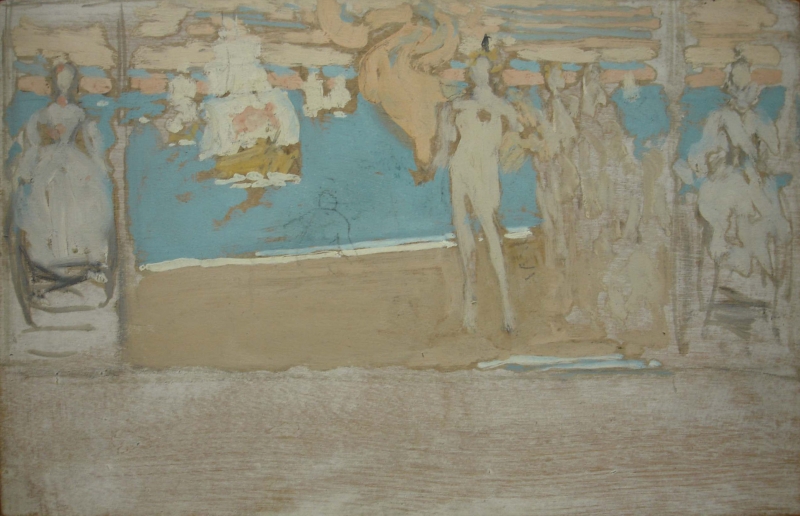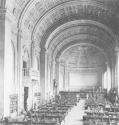Home > Catalogue > Browse > Study for Three Decorative Panels Representing 'The Landing of Columbus', 'Queen Isabel la Católica of Spain' and 'Queen Elizabeth of England’ << >>
Titles
Only minor variations on the long descriptive title are recorded:
- 'the Landing of Columbus, with Queen Isabel la Catolica of Spain and Queen Elizabeth of England' (1970, Whitehill). 1
- "Study for Three Decorative Panels Representing 'The Landing of Columbus', 'Queen Isabel la Católica of Spain' and 'Queen Elizabeth of England" (1980, YMSM). 2
Study for Three Decorative Panels Representing 'The Landing of Columbus', 'Queen Isabel la Católica of Spain' and 'Queen Elizabeth of England is the preferred title.
Description

Study for Three Decorative Panels Representing 'The Landing of Columbus', 'Queen Isabel la Católica of Spain' and 'Queen Elizabeth of England', Boston Public Library
The design, painted on a horizontal panel, incorporates three rectangular areas. Two women in a rough approximation of 16th century costume are painted, facing the viewer, in narrow vertical areas on each side of the large central composition. The central area shows ships with broad white sails on the sea at upper left, and half-naked figures, with billowing robes, standing on the shore. A seated figure is outlined in pencil at the shore's edge, looking out to sea.
Site
The large panel that Whistler was asked to decorate in Bates Hall, Boston Public Library, in Boston, Massachusetts, remains vacant to this day. It is rectangular, about 4 x 9 metres (13 x 32'), on a slightly curved wall. It was described by the architect Charles F. McKim as follows:
'I send you herewith plan and perspective of Bates Hall showing the rectangular panel, of which we talked last winter. We hope to be able to send you the written commission for this work within a few days, Mr. Abbott having just returned from Europe.
Panels, A, B & C explained in plan and perspective form a basis of prospective work which we hope to confide to your hands in the near future -- the object being to form eventually a "Whistler Corner", reached by a door-way through the bronze and marble open grille screen, shown in plan and perspective. Feeling what your wish would probably be, we have urged upon the trustees the importance of reserving these panels for you as a measure of self-protection both for themselves and you, thus preventing the painting of subjects not harmonious with the great rectangular panel in close proximity to it. Please let us know upon what terms you would be willing to paint the whole or any one of these three panels, so that we may be able to control the situation in your interest.
We are expecting to hear soon from the friends of James R. Osgood, who are interested in raising money to employ you for a Memorial to be placed in the Public Library in his name / Say panels A B or C, - or any thing! if [they] can afford it. -- the subject, of course, not to have anything to do with Osgood.' 3
Whitehill commented:
'Although Stanford White wished to procure European painters for the decoration, Augustus Saint-Gaudens insisted that there were "strong men of American fiber who should be employed." So, although Puvis de Chavannes eventually decorated the main staircase, John Singer Sargent and Edwin A. Abbey were also brought into the scene. McKim, White, and Saint-Gaudens clearly saw, in the words of Charles Moore, "the possibilities opening before them for the creation of the greatest combined work of the architect, painter and sculptor ever achieved in America up to that time." ' 4
Whitehill gave a romantic account of discussions between Whistler and the Bostonians:
'Sam Abbott went abroad in various summers, usually with McKim, ... looking into possibilities of decoration. In the hope that Whistler might be persuaded to decorate a large panel at the Boylston Street end of Bates Hall, Sargent arranged a charming dinner at Foyot's in Paris for himself, McKim, Abbott, and Whistler. … Whistler responded, drew sketches on the tablecloth, and his companions marveled. But the tablecloth went into the wash, and nothing tangible came of the meeting, even though the Bates Hall panel was informally reserved for Whistler.' 5
Whitehill's detailed description of the plans for the site is as follows:
'In July 1894, President Abbott was empowered to execute a contract with James A. McNeill Whistler to decorate the wall at the northeasterly end of Bates Hall for $15,000 ... Negotiations with Whistler went so badly, however, that by the spring of 1895 the offer of a contract was withdrawn, to his considerable disgust. This was regrettable, for McKim had gone to great trouble to provide a very conspicuous place in Bates Hall for Whistler's decorations. The handsome arcade of the front of the building, designed around the thirteen great arched windows of this hall, turned the corners and continued along Blagden Street with six arches and along Boylston Street with eleven, the entire length of that northern facade. All contained grilles of the same size and design. The first two windows of the Blagden Street arcade lighted the southern, semicircular end of Bates Hall, but the first two on Boylston Street were blind, being filled not with glass but with Levanto marble. Thus at the northern end of Bates Hall was a great blank panel, crying out for Whistler to introduce color into a room dominated by the soft brownish-gray piers of sandstone, quarried in Amherst, Ohio. Although the panel is still blank three-quarters of a century later, the Print Department of the library has owned since 1950 a tiny suggestion of Whistler's for his proposed decoration. ... Whistler's death in 1903 closed this chapter, alas; one of his symphonies in color, regardless of subject, would have subtly enhanced the prevailing grayness of Bates Hall.' 6
Sitter
The subjects of Whistler's rough draft were central figures in the European settlement of America. Whitehill states: 'The subject is the Landing of Columbus, with Queen Isabel la Catolica of Spain and Queen Elizabeth of England on either side of the main design, although it is so largely a study in blues and grays that the iconography does not spring to the eye.' 7
Queen Isabel I of Spain (1451-1504) – 'Isabel la Católica' – was Queen of Castile (1474-1504) and of Aragon (1479-1504). She ruled the two kingdoms jointly from 1479 with her husband, Ferdinand II of Aragon (Ferdinand V of Castile). Their rule established the unification of Spain, and the beginning of an overseas empire in the New World, led by Christopher Columbus under Isabella’s sponsorship. She and her councillors gave approval for Columbus's expedition to discover a new route to the Indies in 1492, and their discoveries in the New World were, with papal confirmation, annexed to the crown of Castile.
The Italian explorer Christopher Columbus – Cristoforo Colombo/Cristóbal Colón (1450/1451-1506) – is not portrayed, although his ships appear: La Santa María de la Inmaculada Concepción ('La Santa María'), the Santa Clara ('La Niña'), and 'La Pinta', or, at least, rough approximations of such ships. Columbus set out in 1492, and instead of reaching Japan, landed in the Bahamas, on an island he named San Salvador. He made four voyages across the Atlantic Ocean, attempted to establish settlements on the island of Hispaniola, and initiated the Spanish colonization of the New World.
Queen Elizabeth I (1533-1603) was Queen of England and Ireland from 1558 until her death. In 1578 Elizabeth granted permission to Sir Humphrey Gilbert (ca 1537-1583), an advocate of American colonization, 'to discover, search, find out and view such remote heathen and barbarous lands countries and territories not actually possessed of any Christian prince or people.' Since Spain laid claim to much of South and Central America, this meant that English attention was directed further north. After Gilbert's death, she transferred his rights to territory on the east coast of America to his half-brother, Walter Raleigh (1554-1618). From 1584 on Raleigh tried to establish a settlement at Roanoke Island and a colony named 'Virginia' after Elizabeth, the 'virgin queen'. Elizabeth was not inclined to fund these expeditions, any more than Isabel of Spain had been, but her support was vital, and these early attempts laid the basis for later, more successful colonisation.
Comments
Jacques Émile Blanche (1861-1942) thought that Whistler 'knew very well in his heart of hearts that such huge surfaces were not for him.' 8 Blanche was somewhat unspecific in his comment, not being sure where the public library was, 'maybe it was Boston'!
Notes:
1: Whitehill 1970 [more], at pp. 22-24.
2: YMSM 1980 [more] (cat. no. 396).
4: Whitehill 1970 [more], at p. 18.
5: Whitehill 1970, op. cit., p. 19; fig. 4, Bates Hall under construction, p. 20.
6: Whitehill 1970, op. cit., pp. 20-23; he notes, 'I owe my knowledge of the sketch, never previously published, to Sinclair H. Hitchings, Keeper of Prints in the Boston Public Library.'
7: Whitehill 1970, op. cit., pp. 22-24.
Last updated: 4th June 2021 by Margaret






